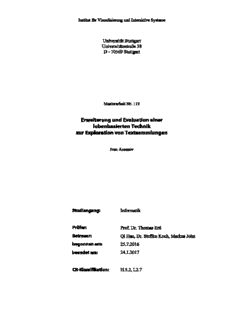
1.2 Aim of This Master's Thesis PDF
Preview 1.2 Aim of This Master's Thesis
II Abstract In recent years there has been a sharp increase in the amount of text pub- licly accessible in digital form. The primary cause for this is widespread access to the Internet, the popularity of e-mail and social networking websites and col- laborative efforts to preserve and share knowledge. These developments have inspired the creation of a wide variety of information visualization techniques that focus on large-scale text data and facilitate its exploration and analysis. One popular approach represents individual documents as glyphs on a 2D sur- face, with pairwise distances corresponding to semantic similarities. The metaphor of a moveable lens that summarizes the contents of texts underneath it has been proposed as a method of interaction targeted at free exploration tasks. The main goal of this master’s thesis project is to extend the basic tech- nique by adding labels to the visualization that guide its users towards regions of interest more quickly without negatively impacting the lens’ usefulness. Also, an automatic framework that determines the tool’s effectiveness under different parameter settings is developed. Finally, the proposed improvements and the overall technique are evaluated by means of a think-aloud user study. III IV Zusammenfassung In den letzten Jahren hat es ein deutliches Wachstum an öffentlich zugänglichen Texten in Digitalform gegeben. Der Hauptgrund dafür ist der Zugriff auf das Internet, die gestiegene Popularität von E-Mails, soziale Netzwerke, und der kollaborative Versuch von Speicherung und Verbreitung von Wissen. Durch diese Entwicklung sind viele Informationsvisualisierungstechniken entstanden, die es ermöglichen große Datenmenge zu explorieren und analysieren. Ein sehr populärerer Ansatz um Dokumente in einer 2D-Ebene darzustellen sind Glyphen. Dabei entspricht die paarweise Distanz der semantischen Ähnlichkeit. Die Metapher einer verschiebbaren Lupe, die den Inhalt fokussierter Texte zusammenfasst, eignet sich für die freie Exploration in einer 2D-Ebene. Das Hauptziel dieser Masterarbeit war es eine vorhandene Grundtechnik zu erweitern, so dass wichtige Begriffe dargestellt werden die den Benutzer unterstützen interessante Bereiche schneller zu finden. Dabei musste darauf geachtet werden, dass die Erweiterung keine negative Auswirkung auf die vorhandene Analysetechnik hat. Des Weiteren, wurde ein automatisches Framework entwickelt, dass die Effektivität mit verschiedenen Parametern misst. Abschließend wurde eine Benutzerstudie durchgeführt, um die Erweiterungen zu evaluieren. V VI Table of Contents List of Figures...................................................................................................IX Chapter 1: Introduction........................................................................................1 1.1 Motivating Examples................................................................................2 1.2 Aim of This Master’s Thesis.....................................................................3 Chapter 2: Background and Related Work..........................................................6 2.1 Standard Information Visualization Model...............................................6 2.2 Natural Language Processing...................................................................7 2.2.1 Tokenization......................................................................................8 2.2.2 Stemming, Lemmatization and Stopwords.......................................8 2.2.3 Bag-of-Words Model......................................................................10 2.3 Text Visualization Techniques................................................................11 2.3.1 Word Clouds....................................................................................12 2.3.2 Document Spatialization.................................................................14 2.3.3 Focus+Context Techniques.............................................................16 2.3.4 DocuCompass.................................................................................19 Chapter 3: Project Architecture.........................................................................22 3.1 Existing Implementation.........................................................................22 3.2 System Overview and Technologies.......................................................25 3.2.1 Prefuse Toolkit................................................................................25 3.2.2 Application Architecture.................................................................26 Chapter 4: Implementation................................................................................29 4.1 Automated Framework...........................................................................29 4.1.1 Automated Logging.........................................................................29 4.1.2 Size of Logging Database...............................................................31 4.1.3 Document Coverage........................................................................32 4.1.4 Document Prominence....................................................................34 4.2 Static Labeling........................................................................................38 4.2.1 Document Clustering......................................................................39 4.2.2 Non-Occluding Static Labeling......................................................42 4.2.3 Static Labeling with Occlusion.......................................................47 Chapter 5: User Study.......................................................................................51 5.1 Research Hypotheses..............................................................................51 5.2 Structure of the Study.............................................................................52 5.2.1 User Logging...................................................................................52 5.2.2 Protocol for Conducting the User Study.........................................53 5.3 Result Analysis.......................................................................................55 Chapter 6: Conclusion.......................................................................................59 Appendix A: User Study Consent Form............................................................60 Appendix B: Basic Technique Questionnaire....................................................61 VII Appendix C: Advanced Technique Questionnaire.............................................66 Bibliography......................................................................................................72 8 List of Figures Figure 1.1: Examples of the growth of textual data over time............................3 Figure 1.2: The DocuCompass TextVis approach...............................................4 Figure 2.1: The standard InfoVis reference model..............................................7 Figure 2.2: Examples of stemming and lemmatization.......................................9 Figure 2.3: Word cloud visualization................................................................13 Figure 2.4: The SPIRE TextVis system.............................................................15 Figure 2.5: Fisheye view of graphs and maps...................................................17 Figure 2.6: The document lens technique..........................................................18 Figure 3.1: The LensMania TextVis technique..................................................23 Figure 3.2: Overview of the Prefuse visualization toolkit.................................26 Figure 3.3: LensMania’s application architecture.............................................27 Figure 4.1: Automated Logging Framework.....................................................30 Figure 4.2: LensMania’s application architecture extended with logging........31 Figure 4.3: Document coverage model.............................................................32 Figure 4.4: Actual document coverage and relative error.................................33 Figure 4.5: Basic prominence model: document view......................................36 Figure 4.6: Basic prominence model: average view.........................................37 Figure 4.7: Basic prominence model: best view...............................................37 Figure 4.8: Basic prominence model: fixed view..............................................38 Figure 4.9: Density-based clustering.................................................................41 Figure 4.10: First static labeling prototype........................................................44 Figure 4.11: Second static labeling prototype...................................................46 Figure 4.12: The final static labeling prototype................................................47 Figure 4.13: Visualization of the push-pull algorithm.......................................49 Figure 5.1: Document coverage during the user study......................................58 IX List of Abbreviations InfoVis information visualization TextVis text visualization NLP natural language processing tf term frequency tf-idf term frequency–inverse document frequency t-SNE t-distributed stochastic neighbor embedding PCA principle component analysis docupoint(s) document point(s) X
Description: